The wonderful world of vintage carousels – Part 1
 The beautiful Canopy and Rounding Boards of the Lakeside Park Carousel – photo by Erica Jurus, all rights reserved
The beautiful Canopy and Rounding Boards of the Lakeside Park Carousel – photo by Erica Jurus, all rights reservedMusic. Hot dogs and ice cream. Sunshine and breezes. Rides.
Memories of childhood summers in the 1900s, and not just in that century. Happily, old-fashioned amusement parks still exist, and families still turn out to enjoy their simpler pleasures, free from timed attractions, long lineups and exorbitant prices.
Summertime when I was growing up: going on all the rides at Lakeside Park in Port Dalhousie. The “Playground of Ontario”, as the park was once known, sits on a wide beach fronting the deep blue waters of Lake Ontario. There’s a lighthouse at the end of a long pier that’s been a fixture of the park for as far back as I can remember, as is the carousel.
It’s the only remaining ride even from the days of my youth, when there were a number of rides including a tower with swinging airplanes (one of my favourites). I wish I’d had the foresight to take photos back then.
In the park’s heyday, though, there were numerous attractions.
The area of the park was located at the entrance of the first Welland Canal, back in 1829, and housed a variety of taverns where the sailors and canal workers would hang out on their down time. When a streetcar service was created linking Port Dalhousie to Niagara Falls in the 1880s (the importance of this will be made clear shortly), along with a passenger steamship across the lake and back from Toronto, the tourist traffic began.
The Niagara, St. Catharines, and Toronto Navigation Company (NS&T), owned by the Railway of the same name, leased the beach and ran tracks from an existing pier across the beach in 1901 to increase business to an area growing in popularity.
With a perfect beach for swimming, food concessions began to pop up, along with amusement rides, from bumper cars, row boats, miniature golf, a water slide, and the carousel, along with a bathing pavilion, a bandstand and dance pavilion, picnic spots and a baseball diamond. There was a variety of live entertainment – bands and orchestras, magicians and other stage shows, and tournaments on the ball field. The Lakeside Inn Restaurant at the ferry pier offered fine dining (85 cents for a full-course meal).
All that remains of those halcyon days is the beach (still well-used), the picturesque lighthouse, the carousel (still running for 5 cents a ride) and a pavilion named for Neil Peart, the drummer for Rush, who worked at Lakeside Park in the 1960s as a carnival barker. In his 2004 book, Traveling Music: Playing Back the Soundtrack to My Life, Neil wrote, “some of the kids brought transistor radios to work, and the music of that summer of 1966 played up and down the midway. At night, when the midway closed, we gathered around a fire on the beach, singing. Lakeside Park resonated in my life in so many deep ways, especially those fundamental exposures to music that would be forever important. It’s all gone now. All that’s left, apart from memories, is the old merry-go-round.”
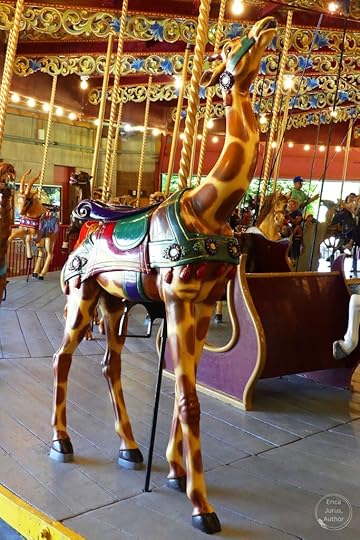 Detailed stationary giraffe at Lakeside Park – photo by Erica Jurus, all rights reserved
Detailed stationary giraffe at Lakeside Park – photo by Erica Jurus, all rights reservedThere’s something about carousels, a kind of mystique behind the elaborate animals that carry riders around, whether stationary (“standers”) or moving hypnotically up and down (“jumpers”).
The Lakeside Carousel was built by Charles I. D. Looff, a master carver and builder based in Riverside, Rhode Island, is credited with making about forty carousels between 1876 and 1916, Only about ten of his forty carousels still survive. They’re known for their lavish decorations, sparkling mirrors and jewels. The lion is an original Looff lion, one of only five existing Looff lions in North America. It’s the only one that has its head turned to watch onlookers as it passes by them.
 The magnificent Looff lion in Port Dalhousie – photo by Erica Jurus, all rights reserved.
The magnificent Looff lion in Port Dalhousie – photo by Erica Jurus, all rights reserved.Old-fashioned amusement parks, where carousels are a starring attraction, are a dying breed. Luckily we recently found one in Bemus Point, NY, and spent a wonderful (if a bit rainy) couple of days exploring it and the surrounding summer resort area.
 Entrance sign – photo by Erica Jurus, all rights reserved
Entrance sign – photo by Erica Jurus, all rights reservedMidway State Park is small, and a far cry from places like Disneyworld, but it’s a delightful slice of history that many people still enjoy, a microcosm of simpler times. I know that’s a terrible cliché, but these days I feel like we could all use such an escape.
Along with being one of the oldest amusement parks in the U.S., Midway is a “Trolley Park” and one of only eleven remaining. At one time, every major American city had at least one of them.
Trolley Parks were the forerunners of amusement parks. They were developed in the 19th century and were located along or at the terminus of streetcar lines as a way to get more customers by providing direct transportation. These parks began with pavilions and picnic areas, which Midway still has, and often held concerts and dances, along with fireworks displays. Eventually more features were added, including carousels, Ferris wheels, and other now-traditional amusement park rides. I think it would be fair to refer to Lakeside Park as a Trolley Park.
 Midway Carousel – photo by Erica Jurus, all rights reserved
Midway Carousel – photo by Erica Jurus, all rights reserved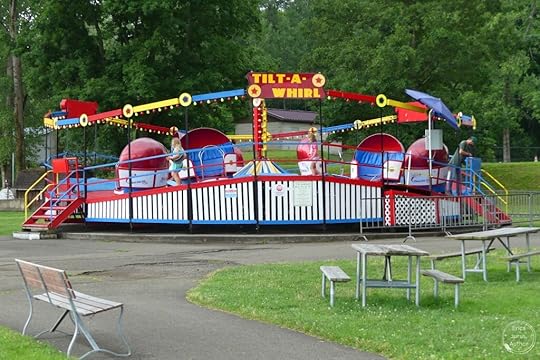 Tilt-A-Whirl ride at Midway State Park – photo by Erica Jurus, all rights reserved
Tilt-A-Whirl ride at Midway State Park – photo by Erica Jurus, all rights reserved Original early 1900s concessions building at Midway State Park- photo by Erica Jurus, all rights reserved
Original early 1900s concessions building at Midway State Park- photo by Erica Jurus, all rights reserved Fabulous fish tacos at the Ellicottville Brewing Co. restaurant in Bemus Point NY – photo by Erica Jurus, all rights reserved
Fabulous fish tacos at the Ellicottville Brewing Co. restaurant in Bemus Point NY – photo by Erica Jurus, all rights reserved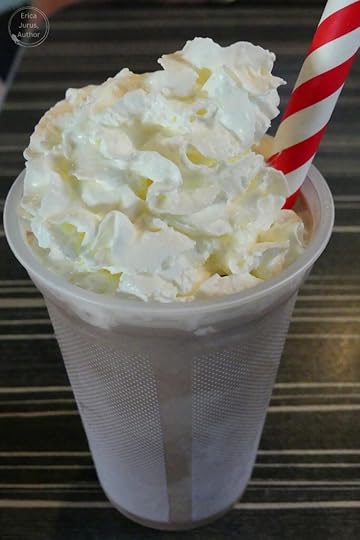 An ‘adult’ version of ice cream: the Chocolate-Peanut Butter Milkshake, with liquor, at Original early 1900s concessions building at Midway State Park- photo by Erica Jurus, all rights reserved
An ‘adult’ version of ice cream: the Chocolate-Peanut Butter Milkshake, with liquor, at Original early 1900s concessions building at Midway State Park- photo by Erica Jurus, all rights reservedWe enjoyed our visit to Midway and the area around Chautauqua Lake. After we got home, I was curious to find out more about the park’s carousel, and discovered that it was built by the Herschell Company in North Tonawanda, NY – only an hour away from where we live. The factory is now a museum, and of course we had to make a pilgrimage to check it out!
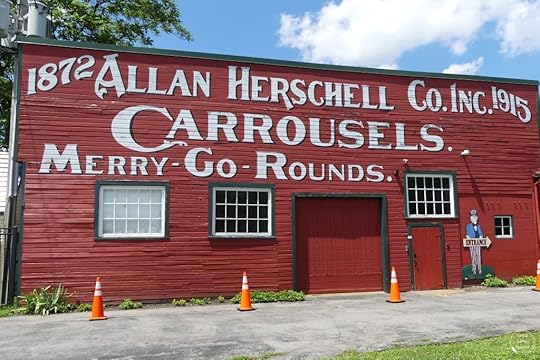 photo by Erica Jurus, all rights reserved
photo by Erica Jurus, all rights reservedWhat a blast from the past! When you arrive, you’re greeted by a vintage military band organ that still has a powerful voice.
 The Artizan military band organ at the Herschell Museum – photo by Erica Jurus, all rights reserved
The Artizan military band organ at the Herschell Museum – photo by Erica Jurus, all rights reservedThis organ still runs with pipes to make the sounds, a bellows to pump air through them, and perforated sheet music to play the classic tunes. You can poke around the back of the beast, and an operator there will happily explain all the workings.
 photo by Erica Jurus, all rights reserved
photo by Erica Jurus, all rights reservedInside the museum, you’re surrounded by colourful artifacts from a bygone age – vintage carousel animals…
 Vintage carousel animals in the museum, including an unusual ostrich – photo by Erica Jurus, all rights reserved
Vintage carousel animals in the museum, including an unusual ostrich – photo by Erica Jurus, all rights reserved… vintage cars from various early amusement parks, including cars from the Little Dipper rollercoaster in Crystal Beach, Fort Erie – a massively popular amusement park in the 1900s …

 Vintage carousel animals in the museum, including an unusual ostrich – photo by Erica Jurus, all rights reserved
Vintage carousel animals in the museum, including an unusual ostrich – photo by Erica Jurus, all rights reserved… and a beautiful carousel inside that you can have a ride on for the price of a cardboard chip (included with admission).
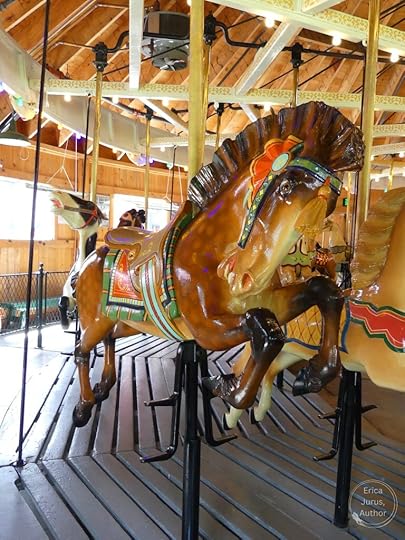 Detail of Herschell Carousel in N Tonawanda, NY – photo by Erica Jurus, all rights reserved
Detail of Herschell Carousel in N Tonawanda, NY – photo by Erica Jurus, all rights reservedThere are vintage signs showing how tall you have to be to ride by yourself.
 photo by Erica Jurus, all rights reserved
photo by Erica Jurus, all rights reservedCarousel animals are an art form, carefully being preserved at the Factory Museum. While modern animals are cast with molds, all the original animals that we’ve all ridden on and loved were meticulously carved by hand.
The process, vividly displayed inside the old factory, began with a detailed drawing, because the animals weren’t made by a single artist, but by several, and everyone had to be on the same page.
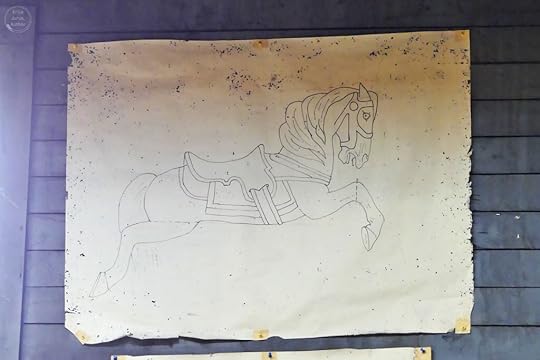 Pre-production diagram of a carousel horse at the Herschell Museum factory – photo by Erica Jurus, all rights reserved
Pre-production diagram of a carousel horse at the Herschell Museum factory – photo by Erica Jurus, all rights reservedThick pieces of wood, usually poplar (for its light weight and ease of carving), were laminated together in sections – the head, the torso and the legs.
The beasties had a small hollow section in the torso, to reduce weight and materials. An average carousel horse weighed only about 80 pounds.
 The carousel animal ‘production line’ at the Herschell factory – photo by Erica Jurus, all rights reserved.
The carousel animal ‘production line’ at the Herschell factory – photo by Erica Jurus, all rights reserved.You’ve probably never noticed (I certainly hadn’t) but carousel animals are only completely carved and finished on the side that faces outward, dazzling viewers waiting to get on the ride. The opposite side is still carved, but not as elaborate.
 The same horse, but on its outward-facing side, considerably more ornate and detailed – photo by Erica Jurus, all rights reserved.
The same horse, but on its outward-facing side, considerably more ornate and detailed – photo by Erica Jurus, all rights reserved.Carvers all had different styles.
Marcus Charles Illions, who carved some of the creatures in the carousel at Lakeside Park, had his own stables so that he could study the motions of his horses. He originated what’s called the ‘Coney Island style’, very flamboyant, with lots of gold and silver decoration. He also usually signed his carvings, as opposed to most carvers. The Lakeside carousel horses still have real horsehair tails. Illions was called “the Michelangelo of carousel carvers” by the New York Times newspaper.
Charles W. F. Dare was originally a manufacturer of children’s toys, including rocking horses. In 1867, his retail/manufacturing business was listed as selling/manufacturing hobby horses, but around that time he transitioned to making carousels. He employed a carver, Andrew Christian, and his company became known for their simplistic horses and figures – often described as primitive and “toy-like”, akin to his earlier work. Nevertheless, all of Dare’s horses had real horsehair tails and manes, along with ears and saddles of leather. His carousels were plain but sturdy, and easy to both transport and store – ideal for travelling fairs and carnivals. One of his features was his “flying horses”, mounted on chains so that as the carousel turned, centrifugal force would allow the horses to “fly” outward.
Some carvers worked for a single company while others moved from shop to shop or supplied figures to more than one company. Many carvers were also manufacturers who made the complete machine, but others, like Marcus Illions, teamed up with another company that made the structured parts of the carousel animals (frames, platforms, machinery).
Records about carvers, who were such skilled masters, are unfortunately sparse because most didn’t sign their animals. At the Herschell factory, although it seems that Allan Herschell himself was never a carver, there were no names of any carvers noted.
Herschell was the largest manufacturer of carousels in the United States. The factory produced over 3000 of them, shipping them throughout North America as well as around the world, including to South Africa, India and Tahiti.
Allan Herschell, had emigrated with his family in 1870 from Scotland to Buffalo, New York. Allan found work in factories, but, an industrious fellow  , at the age of twenty, partnered with James Armitage to create their own business, the Tonawanda Engine and Machine Company in North Tonawanda. However, he was diagnosed with lung disease not long after, and his physician recommended that he move on from manufacturing boilers. A visit to New York City introduced him to carousels (probably one made by Dare), and he built his first one not long after, powered by one of his own steam engines. Within seven years, his factory was producing a carousel every day.
, at the age of twenty, partnered with James Armitage to create their own business, the Tonawanda Engine and Machine Company in North Tonawanda. However, he was diagnosed with lung disease not long after, and his physician recommended that he move on from manufacturing boilers. A visit to New York City introduced him to carousels (probably one made by Dare), and he built his first one not long after, powered by one of his own steam engines. Within seven years, his factory was producing a carousel every day.
In 1903 he bought out the Armitage-Herschell Company and partnered with his brother-in-law, Edward Spillman, forming the Herschell-Spillman Company, the largest manufacturer of carousels in the United States. Their steam-powered carousels were small, with intricately-designed horses, menagerie animals and even storybook characters.
Herschell had to retire a few years later because of ill health, but by 1914, with the help of a carving machine, the Herschell-Spillman company was making large, permanent, park model carousels. Marcus Illions even supplied the horses for one of them.
In 1915, Herschell re-entered the carousel business on his own and founded the Allan Herschell Company in direct competition with the Herschell-Spillman Company. He returned to producing the easily dismantled and packed carousels for traveling carnivals. The first carousel made by his reinvented company, the No. 1 Special, completed in 1916, is still at its original site at the factory my hubby and I visited, and rode, in North Tonawanda, NY.
A number of years ago we’d seen another beautiful carousel at Greenfield Village, part of the Henry Ford Museum in Dearborn, Michigan, and I combed through the photos to include some of that carousel. To my amazement, the artwork on the Greenfield carousel clearly identified it as a Herschell-Spillman creation. Synchronicity hard at work!
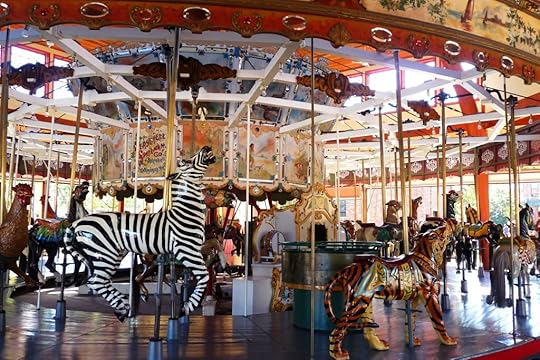 The Herschell-Spillman Carousel in Greenfield Village – photo by Erica Jurus, all rights reserved.
The Herschell-Spillman Carousel in Greenfield Village – photo by Erica Jurus, all rights reserved.That carousel was made in 1913, while Allan Herschell was still part of the company. The craftsmen created the widest variety of hand-carved carousel animals of any manufacturer – zebras, giraffes, storks, sea creatures, and even giant green frogs, produced only by Herschell-Spillman. We saw two of them on the shop floor in North Tonawanda (the photo in last week’s post), and they are also the only carousel animals that wore human clothes.
In Tonawanda we were given an intimate view into the creation of these wonderful rideable animals, as well as the music that’s been an iconic part of carousels since their beginnings. But that’s a story for Part 2, in next week’s blog.
There are about 350 antique hand-carved carousels still operating in North America, including the one at Lakeside Park in Port Dalhousie. Only nine of them are in Canada, which makes Lakeside very special.
I treasure these slices of history and gentler times past. Our visit to the Herschell Carrousel Factory Museum was so much fun; we could easily have spent an entire afternoon just talking with the docent in the factory section. If you’re ever in the area, do go and visit it, and become a child again for a few hours.
180 Thompson Street, North Tonawanda NY, 14120
 Herschell horse with details of glass eyes and jewelled bridle – photo by Erica Jurus, all rights reserved.
Herschell horse with details of glass eyes and jewelled bridle – photo by Erica Jurus, all rights reserved.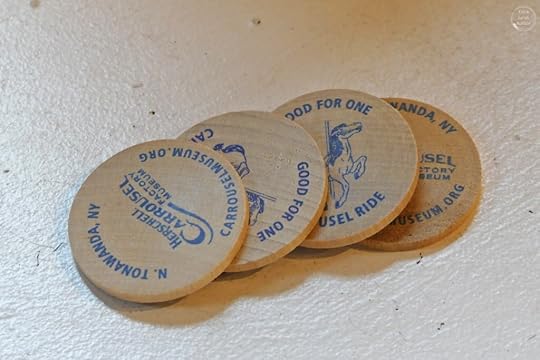 Vintage cardboard tokens to ride the Herschell carousel in N Tonawanda – photo by Erica Jurus, all rights reserved.
Vintage cardboard tokens to ride the Herschell carousel in N Tonawanda – photo by Erica Jurus, all rights reserved.The post The wonderful world of vintage carousels – Part 1 first appeared on Erica Jurus.



